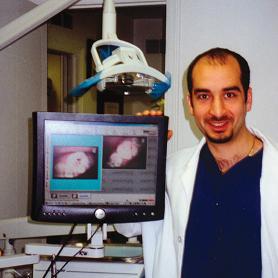In the first of a continuing series of reports on dental and oral health this article will discuss the very dynamic topic of dental implants. Although the concept is quite simple its effect on modern day dentistry is quite astounding. With recent advancements in implantology the benefits available to those who are missing teeth or are struggling with dentures are impressive. Dentists no longer need to “grind down” healthy teeth to fit a bridge and denture wearers no longer have to worry about loose dentures.
Implants can be used to replace one or more missing teeth or to secure dentures via hidden clips. Implant treatment consists of two phases. Phase one is the surgical step in which the implant itself is placed and phase two is the prosthetic step in which the artificial teeth are attached to the implants.
An implant is simply an artificial tooth root, made of titanium, which serves as an anchor or foundation for the prostheses (tooth replacement). The prostheses can be
a Crown (cap), Fixed (permanent) Bridge, or Denture. There is usually a three to six month healing period between the surgical and prosthetic steps, but the use of modern techniques can eliminate this waiting period in some cases.
The placement of the implant itself is a minor surgical procedure that is done in a dental office using local anesthesia, much like when having a root canal procedure or filling done. Being put to sleep is an option for those patients who are anxious about any dental treatment including the placement of implants.
It’s no surprise at all that those who benefit most from implant therapy are denture wearers. One very common misconception is that denture wearers require one implant for every missing tooth, resulting in a financially
prohibitive situation for some. Fortunately this is not the case and denture wearers need not have such cost prohibitive treatment. Although dentures can be eliminated with the placement of several implants, significant mprovements in comfort, chewing ability and quality of life can be made with as few as two implants onto which a denture clips on. Often times the patients’ existing denture can be fitted to the new implants, resulting in increased savings.
Replacing one or just a few missing teeth has historically been accomplished with either a fixed bridge or removable partial denture.
A traditional fixed bridge requires the “grinding down” of otherwise healthy teeth and a removable partial denture has metal clasps, which are cosmetically undesirable.
Additionally both compromise hygiene and place additional stresses on the teeth to which they attach. With the use of dental implants patients now have the option to replace missing teeth without compromising hygiene and additionally burdening the remaining teeth. Resulting in a more comfortable and cosmetic situation. Prior to undertaking implant therapy a thorough medical and dental history review needs to be made with your dentist. Certain uncontrolled medical and dental conditions may make implant treatment a poor choice. Fortunately most medical and dental conditions can be controlled with the use of medications or other treatment methods allowing implant therapy to be safely accomplished.
Bone quantity and quality play an important role in implant treatment. Sufficient amounts of bone are required to allow the placement of implants. When bone levels are not adequate it may be possible to correct the deficiency with bone grafting, allowing subsequent placement of implants. Determining bone quantity is accomplished by clinical examination along with X-Rays. Occasionally a CAT Scan is necessary to make a full evaluation. Age itself plays no role in determining who is or isn’t a candidate for implants. After all nobody is too old to eat, speak and smile comfortably.
Implants have opened up a whole new world of options in dental rehabilitation. It is important to seek the advice of a dentist who is adequately trained, experienced and up to date with current methods in implant dentistry. Only a qualified dentist, one who does them routinely, can advise patients if they are a candidate and what their options are.
For more information you can visit the American Academy of Implant Dentistry’s web site, www.aaid-implant.org or the American Dental Association at www.ada.org.




